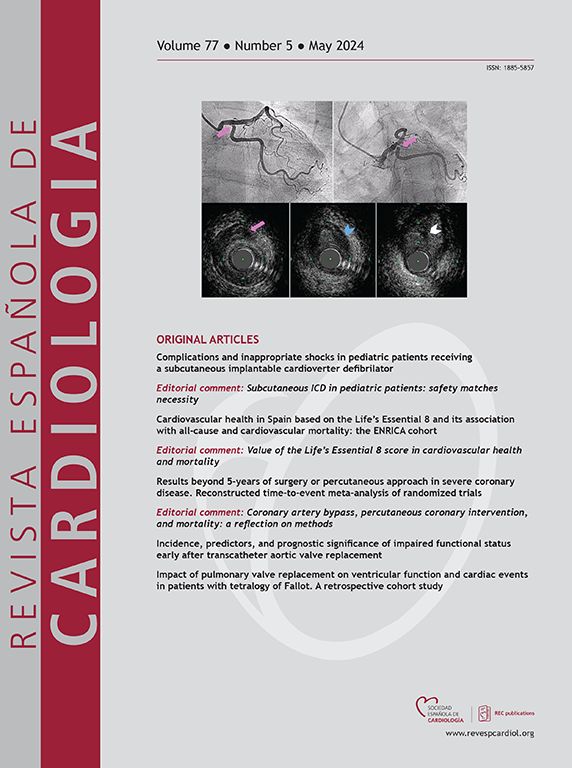Reserva fraccional de flujo u OCT para guiar el tratamiento de estenosis coronarias complejas y no complejas angiográficamente intermedias
IF 5.9
2区 医学
Q2 Medicine
引用次数: 0
Abstract
Introduction and objectives
The management of patients with coronary artery disease can benefit from devices that improve functional or anatomical evaluation. This study aimed to compare the efficacy of optical coherence tomography (OCT) and fractional flow reserve (FFR) guidance for managing vessels with angiographically intermediate coronary lesions according to angiographic lesion complexity.
Methods
The FORZA trial (NCT01824030) was a randomized trial comparing the use of OCT or FFR for revascularization decisions and percutaneous coronary intervention optimization in patients with angiographically intermediate coronary lesions. Complex lesions were defined as long (length > 38 mm), severely calcified, or bifurcation lesions. The primary outcome was major adverse cardiac events (MACE), defined as a composite of all-cause death, myocardial infarction, or target vessel revascularization.
Results
A total of 420 vessels (200 OCT-guided and 220 FFR-guided) were enrolled, including 212 vessels with complex lesions. At the 5-year follow-up, the MACE rate was 20.8% in vessels with complex lesions and 13.9% in vessels with noncomplex lesions (HR, 1.52; 95%CI, 0.95-2.44; P = .078). Compared with FFR, OCT was associated with a lower risk of MACE in vessels with complex lesions (HR, 0.53; 95%CI, 0.28-0.98; P = .044), but with a higher risk of MACE in vessels with noncomplex lesions (HR, 2.23; 95%CI, 1.04-4.81; P = .040; Pinteraction = .004).
Conclusions
In vessels with angiographically intermediate coronary lesions, angiographic lesion complexity may modulate the long-term efficacy of the guidance modality, with a potential benefit of OCT in complex lesions and FFR in noncomplex lesions.
用于指导血管造影中复杂和非复杂冠状动脉狭窄治疗的部分流量储备或近距离观察
介绍和目的冠状动脉疾病患者的治疗可以从改善功能或解剖评价的器械中获益。本研究旨在比较光学相干断层扫描(OCT)和分数血流储备(FFR)指导根据血管造影病变复杂性对冠脉造影中期病变血管的治疗效果。方法FORZA试验(NCT01824030)是一项随机试验,比较使用OCT或FFR进行血管重建决策和经皮冠状动脉介入治疗对血管造影中期冠状动脉病变患者的影响。复杂病变被定义为长(长度>; 38mm),严重钙化或分叉病变。主要终点是主要心脏不良事件(MACE),定义为全因死亡、心肌梗死或靶血管重建术的综合结果。结果共纳入420条血管(oct引导200条,ffr引导220条),其中病变复杂的血管212条。在5年随访中,复杂病变血管的MACE率为20.8%,非复杂病变血管的MACE率为13.9% (HR, 1.52; 95%CI, 0.95-2.44; P = 0.078)。与FFR相比,OCT与复杂病变血管发生MACE的风险较低(HR, 0.53; 95%CI, 0.28-0.98; P = 0.044),但与非复杂病变血管发生MACE的风险较高(HR, 2.23; 95%CI, 1.04-4.81; P = 0.040; P相互作用= 0.004)。结论在冠状动脉造影中度病变的血管中,血管造影病变复杂性可能调节引导方式的长期疗效,在复杂病变中OCT和非复杂病变中FFR具有潜在的优势。
本文章由计算机程序翻译,如有差异,请以英文原文为准。
求助全文
约1分钟内获得全文
求助全文
来源期刊

Revista espanola de cardiologia
医学-心血管系统
CiteScore
4.20
自引率
13.60%
发文量
257
审稿时长
28 days
期刊介绍:
Revista Española de Cardiología, Revista bilingüe científica internacional, dedicada a las enfermedades cardiovasculares, es la publicación oficial de la Sociedad Española de Cardiología.
 求助内容:
求助内容: 应助结果提醒方式:
应助结果提醒方式:


